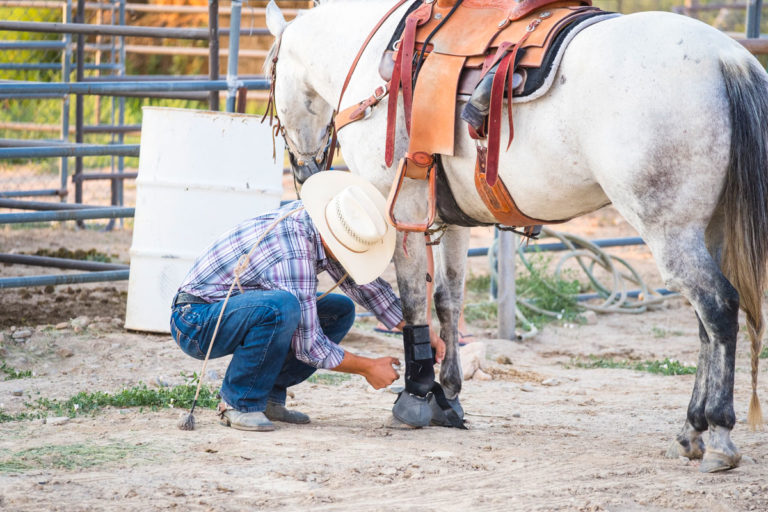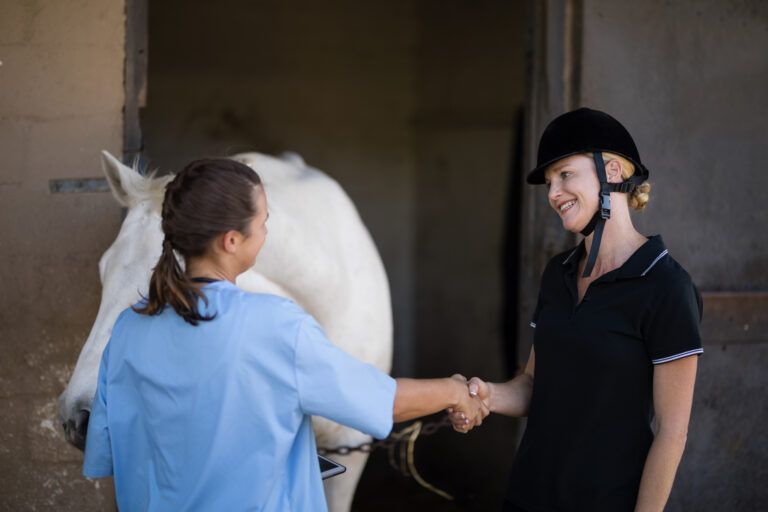
Every equine veterinary practice shares a significant commonality, regardless of its size: You can use the 100 Penny Exercise to calculate its cost of doing business. The 100 Penny Exercise illuminates how the pennies in each dollar a practice receives as revenue are spent on the cost of doing business and accounts for the pennies left over as profit.
“All equine veterinary businesses spend their income on a finite, consistent set of expense categories,” said past AAEP president Ann Dwyer, DVM, during her presentation at the 2023 AAEP Convention. “The proportion of income that is spent on these expenses is remarkably similar in all carefully managed practices, no matter the size or shape of the business.”
Knowing “where the money goes” is crucial to practice management because it establishes the basis for understanding how much money clinics can allocate to veterinary compensation and how profitable the practice will be.
Where Are Your Pennies Going?
The Equine Veterinary Practice Chart of Accounts (EVPCOA) created by Marsha Heinke, DVM, EA, CPA, CVPM, the founder of Veterinary Practice Made Perfect, groups expenses related to the operation of an equine practice into five categories:
- Cost of professional services (or cost of goods sold).
- Facility expense.
- Office expense.
- Labor expense.
- Depreciation expense.
Let’s see how you do in guessing where the pennies go in your practice. Here is a test: Without looking at your books, estimate how many pennies of every dollar (which translates into the percentage of your revenues) you think are going to:
Cost of professional services (or cost of goods sold)
a. 13 cents
b. 23 cents
c. 33 cents
d. 43 cents
Facility expense
a. 5 cents
b. 10 cents
c. 15 cents
d. 20 cents
Office expense
a. 5 cents
b. 10 cents
c. 15 cents
d. 20 cents
Labor expense
a. 21 cents
b. 31 cents
c. 41 cents
d. 51 cents
Depreciation expense
a. 3 cents
b. 8 cents
c. 13 cents
d. 18 cents
Answers to the Quiz: Equine Practice Benchmarks for Expense Categories
Let’s look at how your answers compare to industry benchmarks for each category.
1. The cost of goods sold or the cost of professional services
Best answer is 23 cents; normal range is 22-24 cents or 22-24%.
This is one of the largest groups of expenses for veterinary practices, said Dwyer.
It includes direct costs for delivering equine veterinary services, such as the supplies you need to provide “hands-on” care to patients, she said. “For example, this ranges from medications, vaccines, catheter supplies, bandages, and gloves to feed and bedding if you’re housing horses for care.”
2. Facility costs
Best answer is 10 cents; normal range is 10-11 cents or 10-11%.
According to the EVPCOA, facility expense is associated with providing equine veterinary services. These include ongoing expenditures such as rent, mortgage, property taxes, and maintenance costs for any brick-and-mortar buildings. This category also includes the costs of running and maintaining ambulatory vehicles, business-related phone and internet bills, and building and equipment insurance premiums.
3. Office expenses
Best answer is 6 cents; normal range is 5-6 cents or 5-6%.
The office expense category accounts for the direct costs associated with running the office that serves horse owners and staff. These expenditures can be viewed as those incurred outside direct patient care but are necessary for the business to operate.
“It covers fees for business marketing and advertising as well as charges from credit card processors, bank accounts, and collection agencies,” Dwyer said. “It also covers the price of buying general office and computer supplies, postage and printing expenses, and the costs of paying accountants, payroll companies, and legal counsel.”
4. Labor costs
Best answer is 41 cents; normal range is 40-43 cents or 40-43%.
All the expenses related to hiring and retaining staff fall into the labor expense category. About two-thirds of labor costs are spent on wages, which include paying support staff members as well as veterinary professionals, Dwyer explained. The remainder of labor costs go to various government-mandated taxes and employee benefits.
An often overlooked but substantial portion of labor costs is payroll taxes, including Social Security, Medicare, state and federal unemployment insurance, workers compensation premiums, and other mandatory insurance programs related to payroll. Additional benefit costs associated with labor include employee health insurance premiums, professional liability insurance premiums, employer-sponsored retirement benefits, dues and licenses, and employee continuing education.
“Often, practice owners are surprised by how much of their income goes to various labor costs and all of the government requirements that eat into a paycheck,” Dwyer said.
5. Depreciation
Best answer is 8 cents; range varies but typically runs 5-10 cents or 5-10%.
For accounting and taxation reasons, depreciation expense is a method used to gradually spread out the cost of equipment, vehicles, computers, and other fixed assets.
Depreciation expense is a method of cost allocation, as opposed to the other categories that entail paying bills out of bank accounts. As such, management decisions regarding current tax laws and codes as well as accountant oversight are necessary for the expense entries related to depreciation.
Depreciation expense is associated with major purchases considered “fixed assets” and are intended to be used by the company for longer than a year.
“Although accountants have differing opinions about what equipment and items should be included in the depreciation schedule versus small items that can be written off in the year of purchase, in general, any item that costs more than a few hundred dollars and is anticipated to last longer than a year is taken into account,” Dwyer said.
Professional equipment such as ultrasound machines, digital radiology equipment, laboratory equipment, computer hardware, office equipment, furniture and fixtures, facility maintenance equipment, and practice vehicles are examples of depreciable items frequently used in equine practice.
IRS regulations dictate that many of the pieces of equipment veterinary practices purchase are scheduled to be depreciated on a five-year timeline.
“In simple terms, that would mean that a blood chemistry machine that cost $20,000 would be eligible for $4,000 of depreciation expense in the year that it was purchased and for each of the following four years,” Dwyer said. “If that equipment was ‘written off’ in a straight line like this, the purchase price would be fully expensed after five years.”
6. Profit
Wait … if you add up the “best answers” for the five named expense categories in the quiz, they only total 88 cents! (COGS/23 cents + Facility/10 cents + Office/6 cents +Labor/41 cents + Depreciation/8 cents). It’s not a trick—there is one more “bucket” that collects the remaining 12 cents, and that’s profit.
Dwyer stressed that many practitioners forget to factor in profit. Profit is the lifeblood of any business and essential for practices to thrive and grow. She encourages equine practice owners to budget at least 12 cents of every 100 pennies (12% of all income) for profit. A few years ago, many equine practices showed low profitability, often in the 9% range or lower.
Recently, equine practice profits have increased thanks to careful practice management and greater awareness of good business practices. Industry benchmarking show that today, well-managed equine practices equal or exceed 11% profitability.
The Largest Expense: Labor Costs
Paying staff—veterinarians, technicians, barn workers, and office assistants—comprises the largest expense category for all equine practices. Staff labor expense accounts for one-third of the total spend, and veterinarian labor expense accounts for the other two-thirds.
To illustrate the breakdown of labor costs, Dwyer used a practice that brings in $2 million in revenue as an example.
“In this hypothetical $2 million practice, the total labor expense is 41 cents out of every 100 pennies, or $820,000. The staff wage expense is 12 cents of every dollar, adding up to $240,000. The payroll taxes and benefit costs for staff account for an additional $43,000, bringing total staff labor costs to $283,000. The veterinary labor expense accounts for the remaining $537,000.”
Here is a typical breakdown of wage, payroll tax, and other benefit expense paid out for veterinary labor in an equine practice that has $2 million in revenue:
- $440,000 = W-2 veterinary wages
- $46,400 = Payroll taxes, workers’ compensation, and other payroll premiums
- $13,200 = Retirement plan contributions
- $36,200 = Health and professional liability insurance premiums
- $14,400 = Continuing education, dues, licenses, uniforms, etc.
“All of the government costs that eat into a paycheck are out of your control, both for the employer and for the employee,” Dwyer said. “Government requirements vary somewhat state to state, but employers can elect to offer retirement benefits, a health savings account, and other ‘pretax’ benefits, to save themselves and their employees a little on payroll-associated expense.”
Dwyer emphasized that when practice owners and associates engage in wage negotiations, it’s critical for both parties to keep in mind that for every dollar paid out as W-2 wages, employers will spend 25-30% more money on payroll taxes and benefits, and employees will take home 25-30% less money due to withholdings for their own portion of payroll taxes, personal income taxes, and the money they elect to put into benefit programs like retirement accounts.
Furthermore, she said practice economics dictates that an equine practice can afford to pay direct veterinary compensation costs at a rate of about 27 pennies out of every hundred pennies a veterinarian brings in. Of that sum, about 22 pennies are available for W-2 veterinary wages and the remaining 5 pennies go to payroll-associated taxes and premiums (2.3 pennies) and benefits for the veterinarians (2.7 pennies).
The Bottom Line
Every clinic’s financial stability hinges on careful management of revenue and expenses so each penny contributes to a thriving equine veterinary practice. Every dollar spent directly impacts your practice’s ability to provide top-notch care for clients.
Whether it involves investing in cutting-edge technologies, employee training, or enhancing client services, the strategic deployment of financial resources fuels the overall health of your business. And that can only be accomplished when you know what it looks like in terms of the pennies on the dollar costs of ordinary practice expense categories.
“Understanding established industry benchmarks that detail how these expense categories as well as net profits factor in as percentages of total revenue enables smart practice managers to plan for fair compensation for employees and healthy profits for the long term,” she said.








